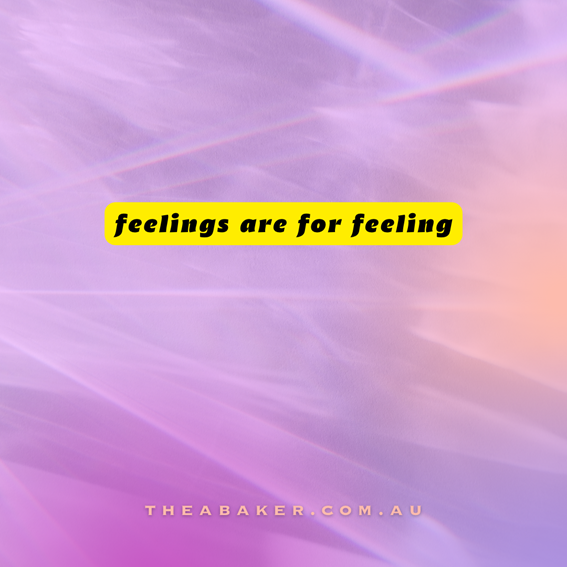Getting comfortable feeling your feelings
Getting comfortable feeling your feelings
In the psychotherapeutic approaches to therapy that I work with, I spend lots of time navigating three different but equally important ‘compass points’ of a person’s inner world; thoughts (think more about the meaning or beliefs we have around certain events or experiences), physical sensations (what is happening in your physical body – tight chest? Butterflies in your tummy? Hurt in your heart? And lastly, there’s feelings (or emotions).
Different people struggle to articulate or connect to different parts of these compass points, for a whole host of different reasons, but it’s kind of like the start point of any of the process-work that we do. Before we can move through (‘heal’ if that’s your language) from our various traumas we need to have an awareness of how it’s affected us. And to do that we need to have to i) have the words for the thoughts, sensations, and feelings and ii) connect to them or as I would say, really know them and how they show up for us as individuals. So, I thought I’d spend the next few weeks shifting through these three areas:
- Thoughts (beliefs, cognitions)
- Physical sensations (where we feel it in our body)
- Feelings (emotions)
This week it’s all about the feelings. And I’m starting there because, at least superficially, I think it’s the easiest of the three for us to wrap our heads around, even though we often struggle to properly articulate how we feel. Emotions can be messy, complicated and confusing to navigate, and even harder to share with someone else.

If feelings are hard to name, it’s probably at least partly related to the fact that us therapists have changed the ballpark over the years around what is and what isn’t a feeling. Paul Ekman, one of the leading researchers on emotions spent time surveying more than 100 scientists and used their input to create what is known as the Atlas of Emotions. At a simplistic level, there are about five core emotions:
- Anger
- Fear
- Sadness
- Disgust
- Enjoyment
His conceptualisation of emotions starts with this core set and then from that groups a whole bunch of words or expressions of those emotions. Some of the training that I have done with Gabor Maté has really encouraged me to help home in on these core emotions because it’s from this foundation that all of the others stem from.
- Enjoyment
Enjoyment is the emotion that we are societally ‘encouraged’ to get on board with. I have a bit of a beef with that whole thing, but I think it’s best I save that for another blog. For now, let’s just go with the idea that most of us like to feel happy, calm or good. We might express these feelings by smiling, laughing or in playful fun. Enjoyment might be more like to be our emotional state when:
- we’re feeling close and connected to the people we care about
- we feel safe and secure
- we’re doing things that bring us pleasure
- we’re absorbed in an activity (flow-state)
- we are relaxed and at ease
The words we might use when we’re feeling enjoyment include:
Happiness Love Relief Joy
Amusement Excitement Peace Contentment
Satisfaction
- Sadness
Sadness is something we all feel from time to time. It might relate to a specific event, such as in the loss of person / job / pet or in instances of rejection and heartbreak. Sometimes we have no idea why we feel sad. Words we use to express sadness include:
Heartbroken Lonely Gloomy Hopeless
Grieved Disappointed Unhappy Lost
Troubled Miserable Resigned
- Fear
Fear happens when we sense a threat. It can be doesn’t matter if that fear is real (actual and present) or something that tethered to a perceived threat (as in PTSD/C-PTSD). Fear can range from a mild unsettled state to a severe trigger response. Remember that level of fear we might feel doesn’t have to match up to the intensity of the threat itself. Peoples living with anxiety or PTSD/C-PTSD might feel severe fear in what might appear low-threat situations. It doesn’t make the fear wrong. Fear language might look like:
Worried Doubtful Anxious Nervous
Terrified Desperate Horrified Stressed
Confused Panicked

- Anger
Anger often comes up when we have experienced an injustice, or when we are feeling threatened, trapped, and unable to defend ourselves. It can be triggered when we have an excess of anxious feelings that have nowhere else to go. Anger, like all emotions is not wrong or bad. When I’m working with clients who are angry, I’m often encouraged because it’s an action-orientated emotion – it’s something that is very present and asking for attention, that is something we can work with! However, when we turn that anger towards ourselves or other people in an unhealthy way then things can get tricky. Anger-related language might include words like:
Annoyed Frustrated Irritated Bitter
Infuriated Mad Cheated Vengeful
Pissed off Insulted Bitter
- Disgust
We often feel disgust in reaction to unpleasant or unwanted situations. It can serve as a means of protecting us from things we want to avoid. But in other situations, it can cause us to dislike people (including ourselves) or situations that aren’t necessarily bad for us. The words that we might use to express disgust might include:
Dislike Revulsion Loathing Disapproving
Offended Horrified Shame Uncomfortable
Nauseated Withdrawn
The two most important things to remember when it comes to feelings are:
- There are no ‘wrong’ or ‘bad’ feelings. They are just feelings.
- Feelings are meant to be felt. But that’s all. Feelings are for feeling.
If you’d like to explore your feelings and would like a safe space to talk about how you’re feeling, please get in touch with us: www.theabaker.com.au / hello@theabaker.com.au / 03 9077 8194.
